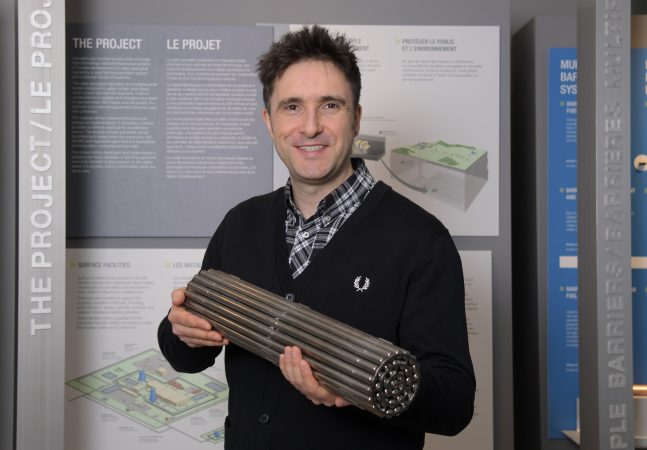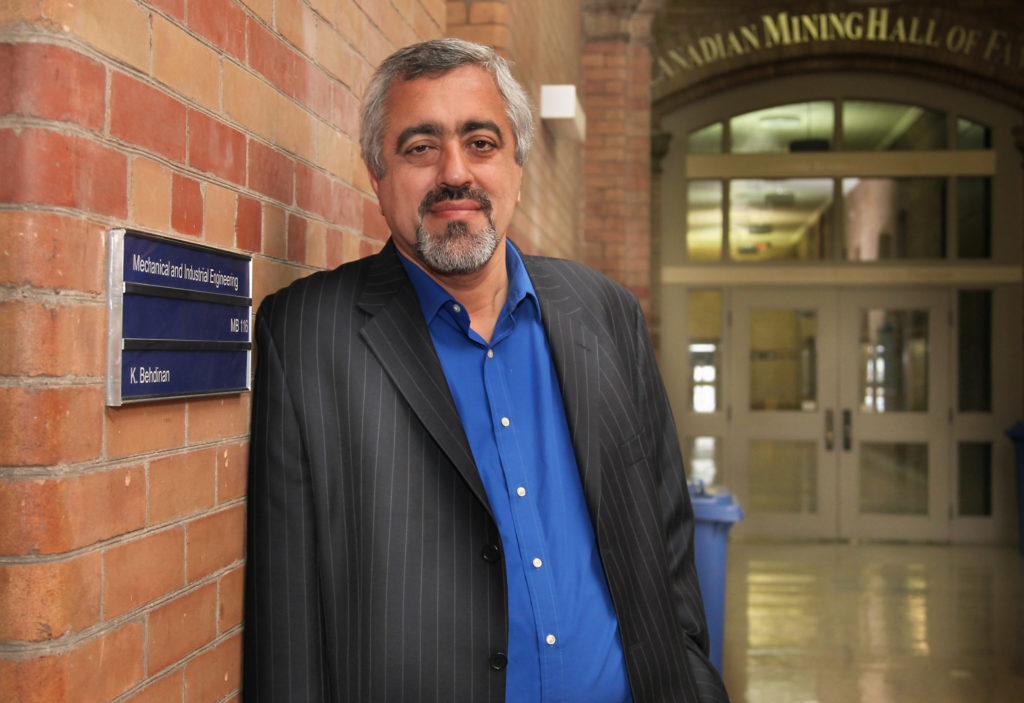
Professor Kamran Behdinan (MIE) and his research team are collaborating with the Nuclear Waste Management Organization (NWMO) to optimize the design and layout of a new plant for processing used nuclear fuel packages.
By leveraging a technique known as multidisciplinary design optimization (MDO), the project aims to further enhance Canada’s long-term management of used nuclear fuel.
“The Used Fuel Packaging Plant will be the first of its kind in Canada,” says Grant Minor (MIE), a senior engineer at NWMO and a flex-time PhD candidate in Behdinan’s lab. “It is a huge infrastructure investment for Canada.”
Currently, 19 Canadian deuterium uranium (CANDU) reactors provide about 15% of Canada’s electricity. The proportion is even higher in Ontario, which is home to three out of Canada’s four operating nuclear plants, and currently sources 56% of its electricity from nuclear power.
Canada’s nuclear waste management plan, called Adaptive Phased Management (APM), is being implemented by the NWMO, a not-for-profit organization formed in 2002 through the federal government’s Nuclear Fuel Waste Act. The organization is responsible for designing and implementing Canada’s plan for the long-term management of used nuclear fuel that is not only safe but socially acceptable.
CANDU reactors are fuelled by a reaction using natural uranium, which is moderated by deuterium, a constituent of heavy water. The fuel goes into pressure tubes that are held by a large cylindrical vessel called the calandria, which holds approximately 5,000 fuel bundles when it is operating, depending on reactor configuration. Each CANDU fuel bundle — around the size of a fireplace log — contains about 20 kilograms of uranium and can power 100 homes for a year. These bundles stay in the reactor for 15 to 18 months.
Once the used fuel is removed from the reactor, it first goes into wet storage, where it sits for seven to ten years before being moved to dry storage. There are about 3.2 million used CANDU nuclear fuel bundles in Canada, which are distributed between the nuclear reactor sites.
Watch: What is Canada’s plan for used nuclear fuel?
The Adaptive Phased Management plan, which is funded by the major owners of nuclear fuel in Canada — Ontario Power Generation, Atomic Energy of Canada Limited, Hydro-Québec and NB Power — requires used fuel to be contained and isolated in a deep geological repository.
But before that can happen, the used nuclear fuel needs to be received from nuclear reactor sites, inspected and repackaged into used fuel containers. This will happen at the Used Fuel Packaging Plant — a key surface facility at the repository site.
Minor’s PhD research is focused on finding an optimal design and layout for this facility, where employees will control every aspect of the process using remote handling techniques, robotics and automated systems.
“The key operation in the Used Fuel Packaging Plant is the handling of highly radioactive nuclear material, so it will have to operate very reliably,” says Minor. “Protection of the environment, public safety and worker safety is and will be NWMO’s highest priority during design, development, construction, commissioning, and future operations and maintenance.
“I saw an opportunity to apply multidisciplinary design optimization to a nuclear facility. Professor Behdinan, a leading expert in MDO, has many years of experience in this technique.”

MDO is a methodology that is used to create systems where multiple engineering disciplines are integrated, such as mechanical, electrical, controls and automation, manufacturing, process, and reliability engineering. It provides a holistic approach to solving multidisciplinary design problems.
Over the past few decades, MDO has traditionally been used in the aerospace and aviation industry and has proven crucial in the structural design of aircraft and their many parts. More recently, Behdinan has applied MDO to automotive, advanced manufacturing and biomedical designs as well.
“This method is very effective when you are dealing with a very complex system,” says Behdinan, who holds the NSERC Chair in Multidisciplinary Engineering Design.
“It is a structured way of interacting between these engineering disciplines, not only for optimization, but to see how design variables within these disciplines interact and affect each other. This allows us to analyze and assess the parts that will be integrated into the overall design of a big system like an aircraft.”
In the case of an aircraft, where every gram of weight matters for fuel efficiency and to maximize the payload — passengers, baggage and cargo — engineers use MDO to evaluate each of their design decisions.
By exploring the mathematical optimization equations used by different engineering disciplines simultaneously, researchers like Behdinan and Minor can see how they relate to each other to create safe and reliable designs that operate as efficiently as possible.
“NWMO is accountable to the public for the safe and reliable design and operation of this Used Fuel Packaging Plant,” says Minor.
“The plant has to process about 120,000 used fuel bundles each year. It has to operate for 250 days a year, while being reliable and cost effective. The facility design must also comply with Canadian Nuclear Safety Commission regulations, other applicable laws, regulations, codes and standards, and engineering best practices.”
Minor has developed an initial framework for a simplified study of the processes that will take place in the Used Fuel Packaging Plant, looking at three disciplines: radiation analysis, cost analysis and reliability analysis.
For example, there will be remotely controlled machinery in the packaging plant to close the used fuel containers, and that machinery will have to operate sequentially to perform the processes on each container. The team is looking at the best way to split the equipment in the processing cells — from setups where all the equipment is in one line, to every single piece of equipment in its own isolated enclosure
The design targets include minimization of the risks associated with management of the used nuclear fuel in the plant. For example, reduction of unnecessary fuel handling steps and unnecessary transfer of used fuel between environments would be a focus.
Minor and Behdinan will be collaborating to create novel optimization techniques for used nuclear fuel disposal facilities that will result in increased safety, improved and reliable operations and cost savings.
“We haven’t seen the application of MDO in the nuclear waste management field,” says Behdinan.
“But there are so many disciplines involved in the overall design of the nuclear waste management system, and this creates many design variables. We want to optimize them because we want to get the best out of the plant. Optimization is always about better solutions.”
– This story was originally published on the University of Toronto’s Faculty of Applied Science and Engineering News Site on February 13, 2023 by Safa Jinje